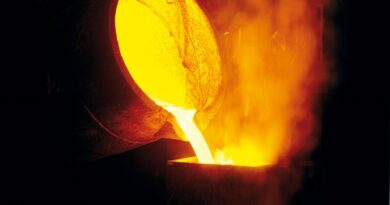High performance refractories for achieving sustainable solutions
Refractory materials have immense potential to create eco-friendly and dependable solutions. Although these materials have been around for centuries, recent technological advances have enabled the harnessing of their incredible potential.
Breakthroughs in nanotechnology have led to nanostructured refractory materials that have improved strength, durability, and resistance to corrosion and erosion.
Additionally, new manufacturing techniques, such as additive manufacturing (3D printing), can create complex refractory shapes and previously impossible designs, opening up new possibilities for using refractory materials in various applications,from aerospace and defence to medical and pharmaceutical industries.
Implementing digital technologies for monitoring and control enhances the performance and efficiency of high temperature processes. For example, using digital sensors to monitor the temperature and condition of refractory materials in real time allows for early detection of damage or wear and prompt maintenance or replacement.
Manufacturers must tailor the practical implementation of applications to fit the specific materials the industry is working with. As such, it’s essential for companies using refractory systems to ensure their solutions align with new situations, environments, and demands as they shift and change over time.
Advancements in refractory lining techniques and equipment
Refractory lining is a crucial part of many industrial processes, providing insulation and protection for high temperature equipment. Over the years, significant refractory lining techniques and equipment advancements have helped improve efficiency, reliability, and durability. This post will discuss some of the most notable advancements in this field.
Advanced Materials
One of the most significant advancements in refractory linings are the use of advanced materials. New materials are being developed that have improved thermal and chemical resistance, making them better suited for high temperature environments and fit for specific purposes. For example, zirconia based materials have been introduced with much higher thermal resistance than traditional refractory materials. This has led to longer lifetimes for refractory linings, reducing the need for frequent replacements.
Precast Refractories
Another advancement in refractory lining is the use of precast shapes. This technique involves manufacturing refractory shapes in a factory and then installing them on site. This is in contrast to traditional cast in place refractory linings cast directly into place. Precast shapes have several advantages, including faster installation times, improved dimensional accuracy, and reduced material waste.
Better Engineering
Computer aided design (CAD) and manufacturing (CAM) have significantly impacted the refractory industry. With these technologies, refractory linings can be designed and manufactured to precise specifications, ensuring that they fit perfectly and provide optimal insulation and protection.
Modern computer simulations have revolutionised the refractory industry by enabling more precise designs and improved accuracy in manufacturing. Finite Element Method (FEM) is one of the most modern IT technologies used for various simulations to help model physical processes on a computer. This method allows engineers to accurately predict how refractory linings will respond to different conditions, making it possible to optimise their design. By combining simulations with advanced materials and precast shapes, the refractory industry has made significant advancements that have revolutionised its practices.
Improved Quality and Monitoring
Finally, quality control and monitoring advances have helped improve the reliability and durability of refractory linings. Non destructive testing techniques, such as infrared scanning, can be used to monitor the condition of the lining and detect any potential issues before they become serious. This has helped to reduce downtime and improve overall efficiency.
Many refractory lining techniques and equipment advancements have improved efficiency, reliability, and durability over the years. Advanced materials, precast shapes, CAD/CAM technologies, and quality control and monitoring have all played a significant role in this progress. These advancements have not only made refractory linings more effective, but they have also helped to reduce waste, improve worker safety, and enhance overall performance.



